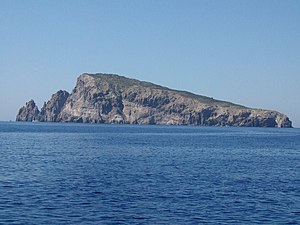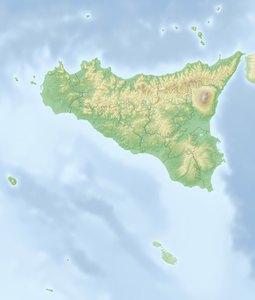Basiluzzo
| Basiluzzo | ||
|---|---|---|
| Basiluzzo, on the left the Scoglio Spinazzola rock | ||
| Waters | Tyrrhenian Sea | |
| Archipelago | Aeolian Islands | |
| Geographical location | 38 ° 39 '48 " N , 15 ° 6' 50" E | |
|
|
||
| length | 856 m | |
| width | 511 m | |
| surface | 29 hectares | |
| Highest elevation | 165 m | |
| Residents | uninhabited | |
| Scoglio Spinazzola and Basiluzzo against the backdrop of the island of Stromboli | ||
Basiluzzo ( siz. Vasiluzzu ) is the name of the largest uninhabited rocky island in the Aeolian Islands . It rises around 3.5 kilometers northeast of Panarea from the Tyrrhenian Sea at around 165 m slm. The island, which is only 29 hectares in size, is surrounded by steep cliffs. 37 meters to the northwest is the 79-meter-high and only 0.55 hectare large rock Scoglio Spinazzola . In the interior of Basiluzzo there is a plain that slopes down to the east. The island has the shape of a large dome and is made of rhyolite . It was formed around 54,000 years ago from the remains of several lava flows, making it the latest volcanic formation in the archipelago. The terrace-like surface inside arose later through erosion. On the seabed southeast of the island there are still gas leaks from the earth's interior.
In the east of the island there are the remains of a pier from Roman times, which is still in use today. A few meters below the surface of the water, further remains of a Roman port facility can be submerged. An ancient stone path leads from this pier to the highest point on the island, from where an iron crucifix offers a panoramic view of all the Aeolian Islands. The numerous remains of ancient buildings, including floor mosaics and wall remains ( opus reticulatum ), suggest the villa of a wealthy owner from the imperial era. Nothing is known about a further settlement, but remains of barley fields indicate that the island was cultivated during the past centuries, originally by residents of Stromboli, then of the closer Panarea. In addition to evidence of human use of the grottoes on the island, the remains of a house and a threshing floor as well as two cisterns were observed at the end of the 19th century.
Basiluzzo belongs to the nature reserve Riserva Naturale Isola di Panarea e scogli viciniori. The vegetation is characterized by rosemary bushes , solstices , thistles, milkweed plants , mugwort , capers and mastic bushes .
Web links
- Marco Anzidei: Basiluzzo oggi on the Ama Panarea page (ital.)
- The Lipari Islands, fourth volume: Panarea (Prague 1895) Extract in Italian translation on the Ama Panarea (Italian) page
- Description on one page about the Italian Marine Protected Areas (ital.)





